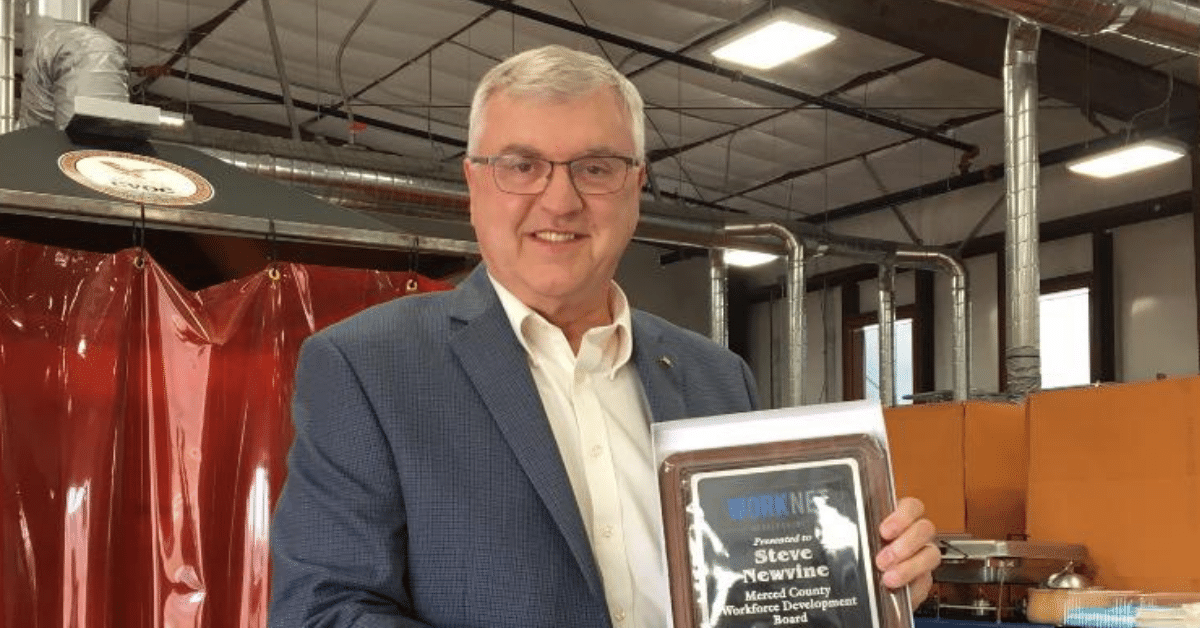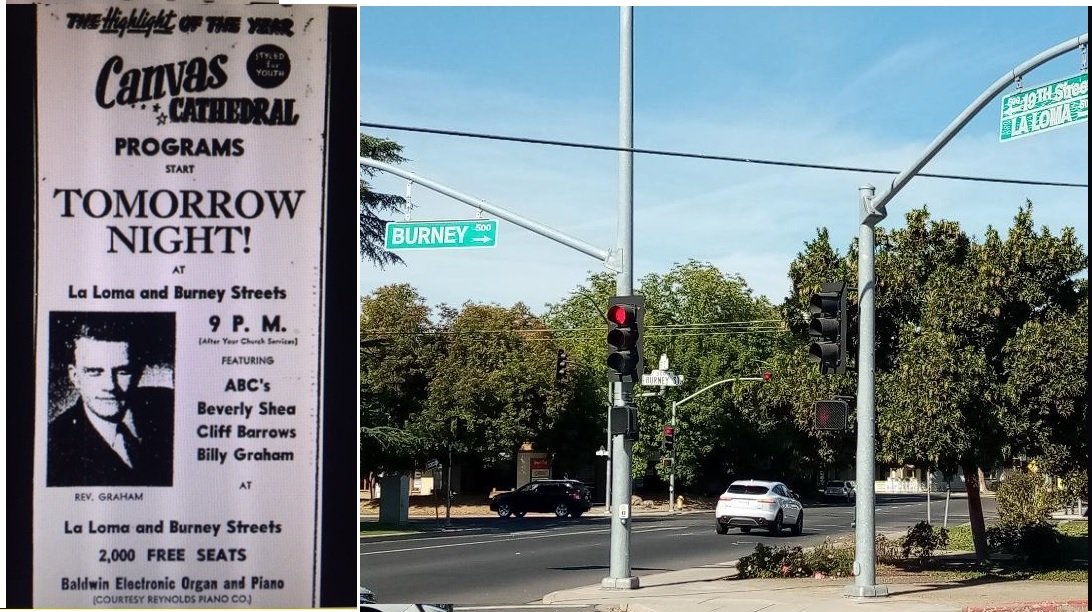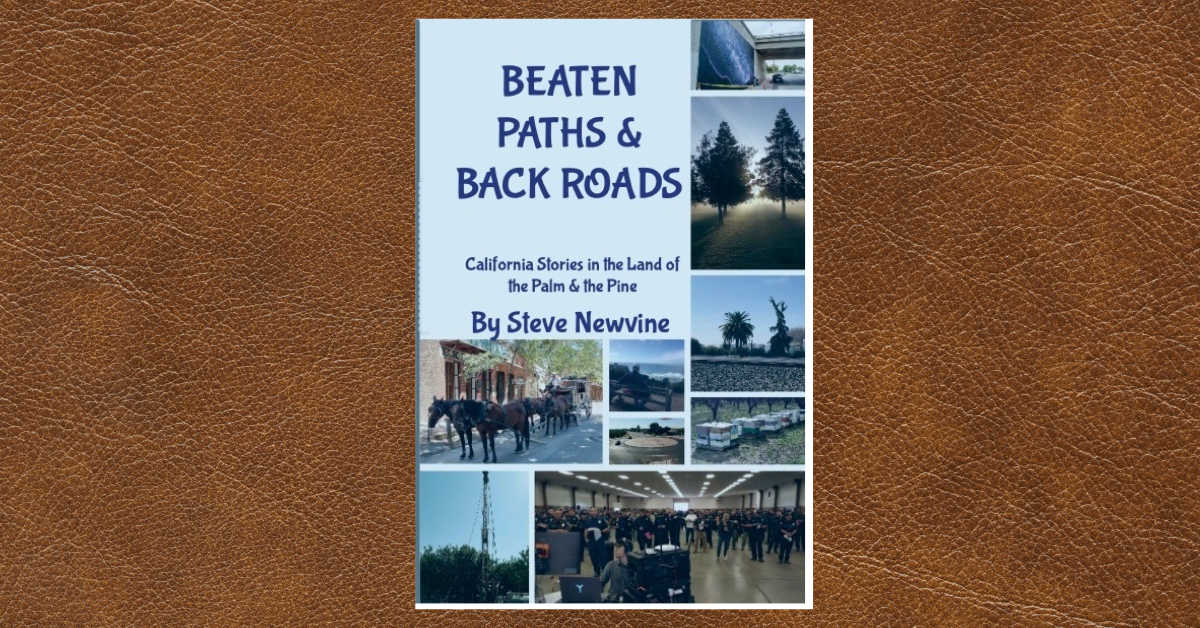
’48 Modesto Crusade Still Reaping Benefits-
75th Anniversary of Billy Graham's Visit to the Central Valley
A poster promoting the Modesto revival meeting with Billy Graham. (right) The intersection of LaLoma Street and Burney Avenue in Modesto where the 1948 revival meetings were held.
October 24, 1948, was a Sunday. A large canvas tent set up in a rural Modesto field was about to be filled with over two thousand people.
For the next two weeks, that tent would fill up every night with more people coming out to hear a special young man speak.
They were there to see a Southern Baptist minister who would preach the Bible by night, and work with his close associates by day to write the rules for a newly formed evangelical organization.
The evangelist was Billy Graham and he was on the precipice of becoming a world-known religious leader. Eleven US presidents would call upon him for spiritual comfort. More than a billion people would hear him preach.
The seventy-fifth anniversary of what became known as the Modesto Crusade was recently noted with little to no fanfare anywhere.
But what took place there three-quarters of a century ago was truly remarkable.
The Crusade ran for two weeks with an estimated twenty-eight thousand people taking part. It was important to the Graham ministry on three fronts: national prominence, the Modesto Manifesto, and the Modesto Gospel Mission.
Pictures from the actual Modesto Crusade are hard to come by. Here is a promotional photo from the Los Angeles Crusade that followed several months after the Modesto stop. Photo: Billy Graham Evangelistic Association
National prominence
The event was an important step that would propel the organization into the national scene. The two-week Modesto Crusade was among the last Graham would lead before heading to Los Angeles.
The Los Angeles Crusade in 1949 would run for eight weeks and bring his preaching to over three hundred thousand people. After the success of the Southern California crusade, the stage was set for a worldwide public ministry.
Modesto Manifesto
A key accomplishment from the Modesto Crusade is what Graham and three of his associates worked on during the day throughout the duration of the event.
Working from the former Rock Motel on the old Highway 99 in Modesto, the team wrote a set of four principles they would call the Modesto Manifesto.
The principles spelled out in the Modesto Manifesto are:
Accountability-transparency in reporting finances and Crusade attendance
Purity-specifically addressing sexual immorality. This led to a directive that no one working for the Graham organization be allowed to have a closed-door meeting with someone from the opposite sex.
Integrity-no criticism of local churches or local pastors
Humility-no seeking out “exaggerated publicity” for the crusade events
A key player in writing the Modesto Manifesto was Billy Graham’s close friend Cliff Barrows.
Barrows grew up in nearby Ceres, Stanislaus County. He went to work with Graham when the preacher hired him to fill a music minister post prior to a revival meeting in North Carolina.
Barrows suggested the Modesto stop hoping that his connections with local churches would make a Central Valley crusade successful. As part of Graham's inner circle, he took part in those daily sessions where the core principles were discussed.
Barrows coined the term Modesto Manifesto.
Two of the early locations of the Modesto Gospel Mission. (lower left) The organization is now on Yosemite Avenue in the City. (lower right) An early sign for the Mission. Archive photos: Modesto Gospel Mission archives.
Modesto Gospel Mission
A continuing example of what made the 1948 Modesto Crusade a success is what was done with excess funds raised from the nightly offerings attendees gave.
With an estimated five thousand dollars from excess offerings from the Crusades, local pastors started the Modesto Gospel Mission.
“There was homelessness in 1948 just like we have now seventy-five years later,” said Modesto Gospel Mission Chief Executive Officer Jason Conway. “Back then, it was more transitory with men coming into Modesto riding in on a boxcar of a train.”
Jason said in the early years, the Mission’s primary work was that of a soup kitchen. “Most of the visitors would get a meal and then move on. Some might stay a day or two, and then they would be on their way.”
That 1948 model has changed a lot. Today, the Mission annually serves nearly a quarter-million meals, shelters about eighteen hundred men, and does the same for over two hundred women and children.
“Today, residency is the focus on most of Modesto’s homeless,” Jason said. “Our clients come here with the intention of staying in the area. That wasn’t the case in 1948.”
This cross sign has been in front of the Modesto Gospel Mission in many of the locations where the organization has been housed. It is now attached to the main building at 1400 Yosemite Avenue in the City.
This effort was made possible because a group of Central Valley pastors invited Billy Graham to bring his revival meetings to Modesto some seventy-five years ago.
There’s no memorial to the Central Valley’s role in the development of the Billy Graham Evangelistic Organization.
While one can find a bronze rendering of the American Graffiti era honoring native son George Lucas, no such memorial exists for that extraordinary two weeks back in October and early November in 1948 when the Modesto Crusade captured the attention of thousands.
But there is what can be considered a memorial to the Billy Graham visit in the work of the Modesto Gospel Mission.
Founded right after the Graham visit, the organization marks a seventieth-fifth year of service along with the Modesto Crusade.
The Mission feeds the hungry, houses the homeless, and helps families throughout the city.
From that five-thousand-dollar investment in human service made possible by the 1948 Modesto Crusade, a living tribute to the work of Billy Graham continues to reap dividends to countless numbers of people who over the years have needed a handout and possibly a hand up in turning their lives around.
It is the living testament to the Manifesto tenet dealing with working with local churches.
It is the true memorial to a historic event in the Central Valley.
Steve Newvine lives in Merced.
He is available for public speaking events at service clubs and other organizations to discuss his new book Beaten Paths and Back Roads.
The book is available for purchase at the Merced County Courthouse Museum gift shop or online at BEATEN PATHS AND BACK ROADS (lulu.com)
For more information on the Modesto Gospel Mission, go to MyMission.org
How they Put Out the Fire 150 Years Ago
Courthouse Museum Helps Merced Fire Department Celebrate Anniversary
Old Betsy, the first piece of firefighting equipment acquired by the Merced Fire Department in 1974. Photo: Steve Newvine
Imagine it is 1874 and a downtown Merced building is on fire.
Someone runs to the nearby Merced Fire House. An alarm is sounded. Volunteer firemen rush to get the gear they need. The station’s pumper, Old Betsy is hauled to the scene of the blaze.
That pumper had been in service in Stockton for more than a decade before being sold to the Merced Fire Department in 1874. The fire department was established one year earlier in 1873.
The organization is celebrating a One hundred fiftieth anniversary this year.
Old Betsy is still here, though long retired.
Vintage firefighting equipment that was part of the opening ceremony for the exhibit titled: 150 Years Later: Old Betsy’s Legacy Continued. Photo: Steve Newvine
For a few decades, Old Betsy was one of the focal points at the Merced County Courthouse Museum.
On loan from the Fire Department, the vintage pumper gave Museum visitors something to admire about the past, something to compare with today’s modern firefighting equipment, and something to look at with a sense of pride.
At a ceremony on October 12 in front of the old Courthouse, the Museum launched the exhibit titled: 150 Years Later: Old Betsy’s Legacy Continued.
Three rooms in the upper level of the Museum have been dedicated to showcasing the development of the city fire department.
Old photographs have been reproduced showing Old Betsy and other pieces of the firefighting arsenal in action.
Memorable fire events such as the destruction of a lumberyard in 1951 are captured in the displays.
That particular blaze could be seen as far south as Fresno and as far north as Modesto according to accounts in the exhibit.
Old Betsy was used in firematics-type competitions and demonstrations up until a crack formed on the pumper’s frame. Photo: Merced County Courthouse Museum exhibit 150 Years Later: Old Betsy’s Legacy Continued.
Old Betsy was already in use by the Stockton department when Merced acquired it one year after forming the fire department.
"It was the first fire engine of the Merced City Fire Department,” Museum Director Sarah Lim said as she wrote about how the engine was built in Rhode Island. “It was shipped around Cape Horn and purchased by Merced from Stockton Eureka Engine Company No. 2 in 1874.”
On the City of Merced website’s fire department history section, the narrative states the name Old Betsy was given by the publisher of the Merced Express local newspaper.
The fire engine was used for over three decades.
Members of the Merced Fire Department engage in a bucket brigade competition as part of the opening ceremony for the exhibit. Photo: Steve Newvine
While Old Betsy was removed from firefighting service as more efficient equipment came online, it was used in fire department competitions and public events.
A crack in the wood frame of the pumper forced a retirement from these activities.
“It is a fantastic representation of the Merced Fire Department,” Fire Chief Derek Parker said. “Old Betsy will return to the firehouse for continued maintenance.”
Chief Parker says the department is in the planning stages of preparing a secured display for Old Betsy.
Eventually, it will be on display at Merced City Hall.
If that continued maintenance is finished in 2024, it may be ready for another welcoming party exactly one-hundred-fifty years after first being brought to the City to help protect the property and people of Merced.
Steve Newvine lives in Merced.
His new book Beaten Paths & Back Roads is available at Lulu.com or at the Merced County Courthouse Museum Gift Shop.
Steve thanks the Atwater Rotary Club and the Merced Women’s Club for hosting him for talks about his new book.
The exhibit 150 Years Later: Old Betsy’s Legacy Continued will be featured at the Courthouse Museum throughout the fall.
Preview of Beaten Paths & Back Roads
New book explores “the other California”
Beaten Paths & Back Roads is available on line at Lulu.com. Locally, the book will be available for sale at the Merced County Courthouse Museum Gift Shop.
My new book is called Beaten Paths & Back Roads.
It contains more than forty stories about places and people all over California with a focus on locations off the so-called beaten path.
In many ways, this is a sequel to the 2017 book California Back Roads. There are just too many stories to write about in just one book.
Here’s a preview
The California Gold Rush was sparked by the discovery of nuggets in the Sacramento Valley. It put California on the radar of the nation.
When gold was discovered at John Sutter’s mill near Coloma in El Dorado County, California in 1848 (the actual year, not 1849 as legend states) the gold rush was on. Soon, the region would fill with prospectors, wannabee gold seekers, and a myriad of service providers.
As news spread of the discovery, thousands of prospective gold miners traveled by sea or over land to San Francisco and the surrounding area. The non-native population of the region exploded from fewer than one-thousand in 1847 to well over one-hundred thousand by 1850.
Resting on a customized park bench as the base of two of the many trees inside Calaveras Big Tree State Park.
Photo: Newvine Personal Collection
While the rush peaked in 1852, some people who look at the era estimate that over two-billion dollars of gold was found during that short period of time.
The rush was effectively over within a few years, but left behind is a beautiful part of the California landscape that visitors now enjoy.
The scenery is spectacular, to coin a word often used by the late California Gold television show host Huell Howser. The region lies north of Yosemite National Park in the Sierra Mountains.
Calaveras Big Tree State Park is a free venue that offers small and medium scale hiking paths among the Sequoia trees.
The trees are the stars of the show. Looking up in some spaces, it is hard to see the tops of the majestic towers of nature.
There are a couple of fallen trees that have been left for visitors to view up close. You get a real idea as to how big these big trees are.
My wife and I posed for a photo in front of the Empire State Tree. As we are transplants from upstate New York, the symbolism of standing next to a tree named for our native state really hit home.
The park had a gift shop that had just the right number of taxidermy wild animals to impress the visitor.
My suggestion is to save the gift shop visit until the very end.
Otherwise, you might be on the lookout for an angry wildcat or wolf just like the ones preserved for posterity in the gift shop.
There’s too much to document in these pages, but permit me to share three venues that have provided natural beauty, with a link to the state’s motion picture history, with a little Broadway thrown in.
Steve Newvine lives in Merced.
Beaten Paths and Back Roads is available now on Lulu.com.
After October 5, copies will be available for sale at the Merced County Courthouse Museum gift shop.
Steve is launching the new book at a meeting of the Merced Women’s Club on October 3.




















To explore Steve Newvine's complete collection of books, simply click on the link below.
CLICK HERE
Steve is also open to delivering speeches for service club programs and other public speaking engagements.
Contact him at: SteveNewvine@sbcglobal.net